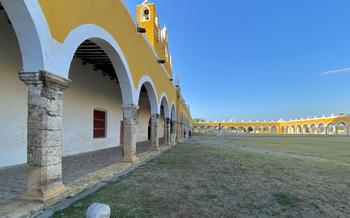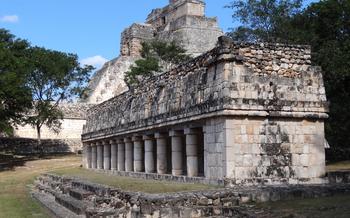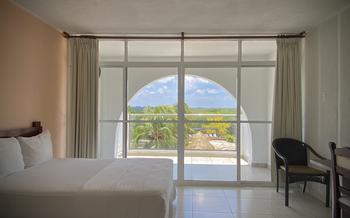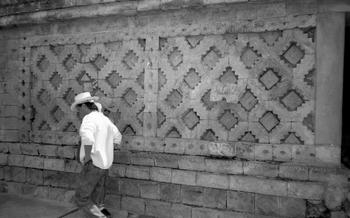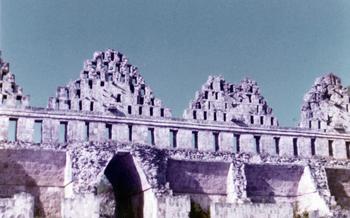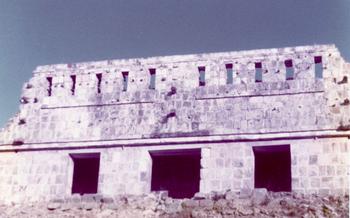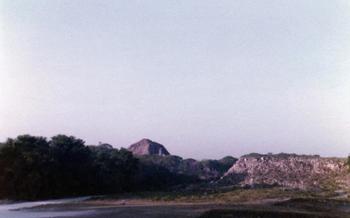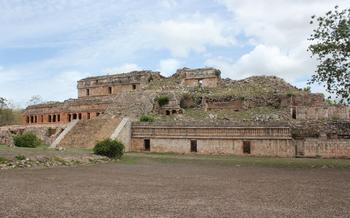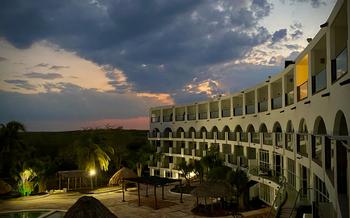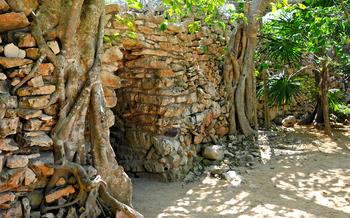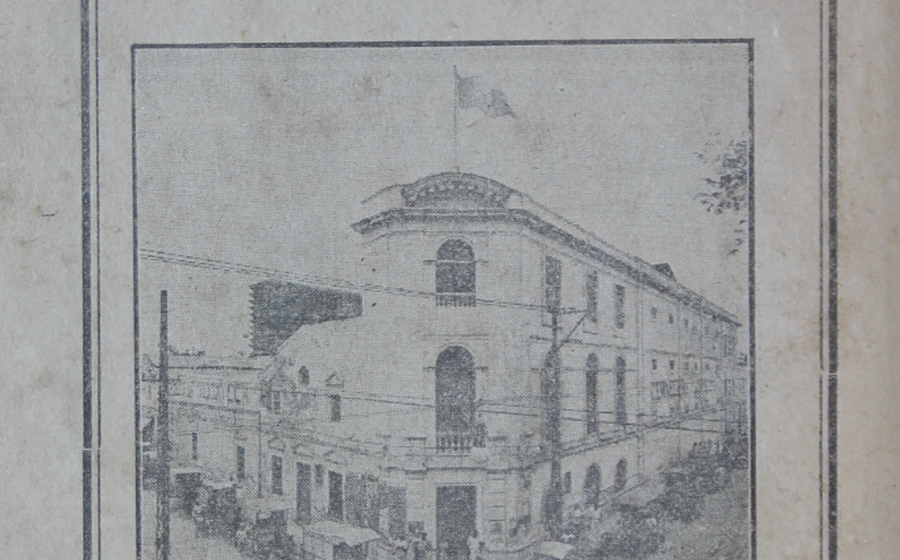
Puuc Route Archaeological Sites
- Exploring Ancient Mayan Wonders: Unveiling the Puuc Route's Archaeological Sites
- Uxmal: A Masterpiece of Puuc Architecture
- Kabah: Unveiling the Codz Poop and the Arch of Kabah
- Sayil: Discovering the Restored Palace and Grand Plaza
- Labna: Exploring the Mirador and Palace
- Xlapak: Uncovering the Hidden Gem of the Puuc Route
- Exploring Cenotes: A Refreshing Dip in Nature's Pools
- Local Cuisine: Indulging in Yucatecan Delights
- Cultural Immersion: Discovering Mayan Traditions and Crafts
- Accommodation Options: Finding Your Home Away from Home
- Transportation: Navigating the Puuc Route
- Budgeting for Your Adventure: Planning Your Expenses
- Money-Saving Tips for Budget Travelers
- Splurging on Unique Experiences
- Personal Anecdote
- Safety Tips: Ensuring a Secure Journey
- Packing Essentials: What to Bring for Your Trip
- Insider Tip: Uncovering Hidden Gems Off the Beaten Path
Exploring Ancient Mayan Wonders: Unveiling the Puuc Route's Archaeological Sites
The Puuc Route, a captivating circuit of ancient Mayan cities nestled in the heart of Mexico's Yucatan Peninsula, offers a journey through time, unveiling the splendor of a once-mighty civilization. This region, renowned for its unique architectural style characterized by intricate carvings and soaring pyramids, beckons travelers to embark on an exploration of its rich history and cultural heritage.
The Puuc Route, named after the Puuc hills that dominate the landscape, comprises several significant archaeological sites, each showcasing distinct features and captivating stories. Uxmal, Kabah, Sayil, Labna, and Xlapak are among the most prominent sites, inviting visitors to immerse themselves in the grandeur of ancient Mayan civilization.
To fully appreciate the wonders of the Puuc Route, it's essential to choose the right time for your visit. The dry season, from November to April, provides the most favorable weather conditions for exploring the region's archaeological treasures. During this time, the skies are clear, the humidity is low, and the temperatures are pleasant, ensuring a comfortable and enjoyable experience as you delve into the mysteries of the past.
Uxmal: A Masterpiece of Puuc Architecture
Amidst the Yucatan Peninsula's dense jungle, the ancient city of Uxmal stands as a testament to the ingenuity and artistry of the Maya civilization. As you approach the site, the towering Pyramid of the Magician emerges from the treetops, a majestic symbol of the city's grandeur.
Uxmal's architecture showcases the distinctive Puuc style, characterized by its intricate carvings, rounded corners, and corbelled arches. The Governor's Palace, one of the most impressive structures, features a series of interconnected rooms adorned with detailed bas-reliefs depicting mythological scenes and everyday life. The Nunnery Quadrangle, with its elegant columns and vaulted ceilings, is another must-see attraction.
To fully appreciate Uxmal's beauty, take your time exploring the site. Climb the steep steps of the Pyramid of the Magician for panoramic views of the surrounding jungle. Wander through the narrow alleyways, marveling at the intricate carvings that adorn every corner. And don't forget to capture the perfect shot of the setting sun casting long shadows across the ancient city.
Kabah: Unveiling the Codz Poop and the Arch of Kabah
Kabah, located just a short distance from Uxmal, is another significant site along the Puuc Route. It is believed to have been closely associated with Uxmal, and its architectural style shares many similarities. The site's name, Kabah, means "curved hand" in the Maya language, possibly referring to the shape of a nearby hill.
One of the highlights of Kabah is the Codz Poop, a large palace structure that dominates the site. The Codz Poop features a series of masks representing the Maya rain god Chaac, along with other intricate carvings and decorations. The palace also has a unique curved shape, which is believed to have been inspired by the nearby hill.
Another must-see structure at Kabah is the Arch of Kabah. This impressive archway stands at the entrance to the site and is one of the most iconic landmarks of the Puuc Route. The arch is decorated with elaborate carvings, including representations of the Maya ruler K'inich Janaab' Pakal and his wife, Lady Sak K'uk'.
Kabah is a fascinating site that offers a glimpse into the close relationship between the ancient Maya cities of Uxmal and Kabah. Its unique architectural features and historical significance make it a must-visit destination for anyone exploring the Puuc Route.
Sayil: Discovering the Restored Palace and Grand Plaza
Sayil, a lesser-known gem among the Puuc Route's archaeological sites, offers a captivating glimpse into the ancient Mayan civilization. Its name, meaning "place of ants," alludes to the industriousness of the Maya people who once inhabited this site. Sayil's well-preserved structures, including the restored Palace and the Grand Plaza, provide a glimpse into the grandeur and artistry of the Puuc architectural style.
The Palace, the most prominent structure at Sayil, showcases the intricate carvings and decorative elements characteristic of Puuc architecture. Its facade is adorned with intricate geometric patterns, animal motifs, and human figures, offering a glimpse into the artistic prowess of the Maya builders. The Grand Plaza, a spacious ceremonial space, is flanked by impressive structures, including the Palace, the North Temple, and the South Temple.
Exploring Sayil offers a unique opportunity to immerse yourself in the history and culture of the ancient Maya. Take your time wandering through the site, admiring the intricate details of the buildings and imagining the lives of the people who once lived here. The site is relatively small, making it easy to explore in a few hours, but its significance and beauty make it a must-visit for any traveler interested in Mayan history and culture.
To enhance your visit, consider hiring a guide who can provide insights into the history and significance of the site. Also, visit the nearby Museo de Sitio de Sayil, which houses a collection of artifacts and exhibits that provide further context to the site's history.
Labna: Exploring the Mirador and Palace
Venturing into the heart of the Puuc Route, discover the captivating ancient city of Labna, a testament to the ingenuity and artistry of the Maya civilization. Among its remarkable structures, the Mirador and Palace stand out as must-see attractions, offering a glimpse into the grandeur of Labna's past.
The Mirador, a towering structure that dominates the site, beckons visitors to climb its steep steps, rewarded with breathtaking panoramic views of the surrounding landscape. From this vantage point, the vast expanse of the Puuc region unfolds, dotted with verdant forests and ancient ruins, a reminder of the Maya's deep connection to their environment.
Descending from the Mirador, explore the intricate details of the Palace, a sprawling complex showcasing the finest examples of Puuc architecture. Admire the elaborately carved facades, adorned with intricate motifs and human figures, which narrate stories of the Maya's mythology and history. Each room and courtyard within the Palace reveals new wonders, transporting visitors back in time to experience the grandeur of Labna's royal court.
Don't miss the Arch of Labna, an iconic structure that serves as the gateway to the city. This impressive arch, with its corbelled vault ceiling and intricate carvings, is a testament to the engineering prowess of the Maya. As you pass beneath the arch, feel the weight of history and imagine the bustling streets of Labna centuries ago.
Practical Information:
- Entrance fees: Approximately $10 USD per person
- Hours of operation: 8:00 AM to 5:00 PM daily
- Guided tours are available for a more in-depth exploration of the site and its history.
Xlapak: Uncovering the Hidden Gem of the Puuc Route
Often overlooked by visitors, Xlapak is a hidden gem nestled within the Puuc hills, offering a tranquil retreat from the more crowded archaeological sites. Its well-preserved structures and serene atmosphere make it a must-visit for those seeking a deeper connection with the region's ancient past.
While Xlapak may not possess the grand scale of Uxmal or Kabah, its charm lies in its intimacy and seclusion. Explore the remarkably intact Palace, adorned with intricate carvings and friezes depicting scenes from Mayan mythology. Marvel at the Grand Plaza, where once upon a time, the Maya gathered for important ceremonies and rituals.
To truly appreciate Xlapak's magic, venture beyond the main complex and discover hidden corners where nature and history intertwine. Unearth ancient altars nestled amidst lush vegetation, and let your imagination transport you back in time as you decipher the stories etched into the stones.
Although Xlapak is less visited compared to other sites along the Puuc Route, its significance should not be underestimated. Its well-preserved state offers a unique opportunity to immerse yourself in the daily life of the ancient Maya and gain insights into their culture and traditions.
To fully experience the tranquility of Xlapak, plan your visit during the early morning hours or late afternoon when the crowds have dispersed. Allow ample time to wander through the site at your own pace, absorbing the serene atmosphere and connecting with the spirit of this hidden gem.
Exploring Cenotes: A Refreshing Dip in Nature's Pools
The Puuc Route is home to a myriad of cenotes, natural swimming pools formed by the collapse of limestone bedrock, revealing crystal-clear waters. These cenotes offer a refreshing respite from the tropical heat and provide a unique opportunity to immerse yourself in the region's natural beauty.
Must-Visit Cenotes:
-
Cenote X-Canche: Located near the town of X-Canche, this cenote is easily accessible and features a large open cenote with a wooden platform for easy access.
-
Cenote Samula: Situated near the town of Oxkutzcab, Cenote Samula is a hidden gem that offers a more secluded and intimate experience. The cenote is surrounded by lush vegetation and features a small cave with stalactites and stalagmites.
Safety Precautions:
-
Wear appropriate footwear: The rocks around cenotes can be slippery, so it's essential to wear shoes with good traction.
-
Don't dive: The depth of cenotes can vary, and there may be hidden obstacles below the surface. Always enter the water feet first.
-
Be aware of your surroundings: Cenotes are home to various wildlife, including bats, spiders, and snakes. Be cautious and avoid disturbing the animals.
Local Cuisine: Indulging in Yucatecan Delights
Yucatecan cuisine is a symphony of flavors, a harmonious blend of Mayan, Spanish, and Caribbean influences. The region's unique ingredients, such as achiote, habanero peppers, and sour orange, create dishes that are both bold and balanced.
Must-try dishes include cochinita pibil, a slow-roasted pork dish marinated in achiote paste and wrapped in banana leaves, and papadzules, corn tortillas filled with hard-boiled eggs, pumpkin seed sauce, and topped with a tomato sauce.
For an authentic Yucatecan experience, venture beyond tourist traps and seek out local restaurants frequented by locals. Ask your hotel concierge or a local tour guide for recommendations.
Indulge in the flavors of Yucatan, savor the culinary delights that have captivated locals and visitors alike. Embrace the vibrant food culture, and let your taste buds embark on a journey of discovery.
Cultural Immersion: Discovering Mayan Traditions and Crafts
Beyond the archaeological wonders, the Puuc Route offers a rich tapestry of Mayan traditions and crafts. Embrace the opportunity to interact with local Maya communities, who have preserved their ancestral customs and skills. Visit their villages and witness traditional ceremonies, dances, and music performances. Learn about their way of life, their beliefs, and their connection to the land.
Immerse yourself in the vibrant world of Mayan crafts. Explore local markets and workshops, where artisans showcase their skills in intricate weaving, pottery, and woodworking. Discover the vibrant colors and patterns of handwoven textiles, including hammocks, table runners, and traditional clothing. Admire the intricate designs of hand-painted pottery, often depicting scenes from Mayan mythology and everyday life.
Supporting local artisans is not only a way to acquire unique souvenirs but also a means of promoting sustainable tourism. By purchasing their products, you contribute to the preservation of traditional Mayan crafts and help ensure that these skills are passed down to future generations. Look for cooperatives and fair-trade organizations that work directly with artisans, ensuring that they receive fair compensation for their work.
Cultural immersion in the Puuc Route is not just about visiting ancient ruins and admiring beautiful crafts; it's about connecting with the living culture of the Maya people. Embrace the opportunity to learn, to share, and to create meaningful connections that will deepen your understanding of this fascinating region.
Accommodation Options: Finding Your Home Away from Home
The Puuc Route offers a diverse range of accommodation options to suit every budget and preference. For budget-conscious travelers, hostels and guesthouses provide affordable stays in shared dormitories or private rooms. Mid-range options include small hotels and bed and breakfasts, offering comfortable rooms with basic amenities. For a luxurious experience, the region boasts several upscale resorts with private pools, spas, and gourmet restaurants.
Recommended areas to stay:
-
Uxmal: Stay within walking distance of the archaeological site for easy access and a chance to explore the ruins at sunrise or sunset.
-
Muna: This charming town, located 15 kilometers from Uxmal, offers a more local experience and a variety of budget-friendly accommodation options.
-
Merida: The capital city of Yucatan, Merida, is a great base for exploring the Puuc Route. It offers a wide range of accommodation options, from budget hostels to luxury hotels, as well as easy access to transportation and guided tours.
Tips for booking accommodation:
-
Book in advance:, especially during peak season (November to April), to avoid disappointment and secure the best deals.
-
Consider your budget and preferences: Decide whether you prioritize proximity to the archaeological sites, amenities, or a specific price range.
-
Research local reviews: Read online reviews and ratings to get a sense of the quality and atmosphere of different accommodations.
Transportation: Navigating the Puuc Route
Exploring the Puuc Route requires careful planning regarding transportation. Navigating the region can be done through various means, each offering unique advantages and drawbacks.
Rental Cars:
Renting a car is a popular option for those seeking flexibility and independence. It allows you to set your own pace, explore at your leisure, and venture off the beaten path. However, it requires careful consideration of insurance coverage, fuel costs, and the region's road conditions.
Guided Tours:
Guided tours offer a hassle-free way to explore the Puuc Route. They provide transportation, knowledgeable guides, and often include additional activities like cenote swims or visits to local villages. While convenient, guided tours can be more expensive and limit your flexibility in terms of itinerary and pace.
Public Transportation:
Public transportation, primarily buses, is a budget-friendly option but requires more planning and flexibility. Buses can be infrequent and may not always reach all the desired sites. However, it offers a chance to interact with locals and experience the region's daily life.
When choosing your mode of transportation, consider your budget, time constraints, and desired level of flexibility. Renting a car provides the most freedom but can be more expensive. Guided tours offer convenience but limit spontaneity. Public transportation is a budget-friendly option but requires careful planning.
Budgeting for Your Adventure: Planning Your Expenses
Exploring the Puuc Route can be a budget-friendly adventure or a luxurious extravaganza, depending on your preferences and travel style. Accommodation options range from budget hostels and guesthouses to luxurious haciendas and eco-lodges. Food costs can be kept low by eating at local markets and restaurants, while transportation expenses can be minimized by renting a car or joining a guided tour. Entrance fees to the archaeological sites are reasonable, and there are often discounts for students and seniors.
Money-Saving Tips for Budget Travelers
- Stay in hostels or guesthouses instead of hotels or resorts.
- Eat at local markets and restaurants instead of tourist traps.
- Cook your own meals if possible.
- Take advantage of free activities, such as swimming in cenotes and hiking in the jungle.
- Look for discounts on entrance fees and guided tours.
- Travel during the shoulder season (May-June and September-October) to avoid peak season prices.
Splurging on Unique Experiences
- Stay in a luxury resort or hacienda for a truly unforgettable experience.
- Hire a private guide to take you on a personalized tour of the Puuc Route.
- Take a cooking class to learn how to prepare traditional Yucatecan dishes.
- Go on a cenote diving or snorkeling excursion.
- Visit the nearby city of Mérida for a day trip or two.
Personal Anecdote
During my travels through the Puuc Route, I opted for a budget-friendly approach, staying in hostels and eating at local markets. This allowed me to save money while still having an incredible experience. I was able to visit all of the major archaeological sites, swim in several cenotes, and indulge in delicious Yucatecan cuisine without breaking the bank. However, I did splurge on one unique experience: a private guided tour of Uxmal. It was worth every penny, as I learned so much about the history and culture of the Maya from my knowledgeable guide.
Safety Tips: Ensuring a Secure Journey
Venturing into the Puuc Route, like any travel destination, requires adherence to basic safety measures. While the region is generally safe for travelers, it's essential to be aware of potential risks and take necessary precautions.
General Safety Tips:
- Inform your hotel or tour operator about your travel plans and estimated return time.
- Keep valuables, including passports and cash, in a secure location.
- Avoid walking alone at night, especially in isolated areas.
- Be cautious when accepting unsolicited offers for tours or services.
- Trust your instincts; if a situation feels unsafe, remove yourself from it.
Exploring Archaeological Sites and Cenotes:
- Wear sturdy shoes for uneven terrain and comfortable clothing for warm weather.
- Bring plenty of water and snacks to stay hydrated and energized.
- Be mindful of your surroundings and avoid climbing or touching fragile structures.
- Respect the cultural significance of the sites and refrain from removing artifacts or disturbing wildlife.
- When swimming in cenotes, choose designated areas and follow safety guidelines.
Avoiding Petty Crime and Scams:
- Be wary of individuals offering unsolicited goods or services.
- Ignore requests for money or donations from strangers.
- Carefully examine bills and coins before accepting them as change.
- Keep an eye on your belongings, especially in crowded areas.
- If you witness or experience any suspicious activity, report it to local authorities.
By following these safety tips, you can minimize risks and ensure a safe and enjoyable journey through the Puuc Route. Remember, personal safety is paramount, so always prioritize your well-being and be vigilant in your surroundings.
Packing Essentials: What to Bring for Your Trip
Comfortable Shoes: Walking on uneven surfaces and climbing ancient ruins requires sturdy and comfortable footwear. Opt for hiking boots or sneakers with good arch support.
Sun Protection: The Yucatan sun can be intense, so pack a hat, sunglasses, and sunscreen with a high SPF. Reapply sunscreen throughout the day, especially after swimming.
Insect Repellent: Mosquitoes and other insects are common in the region, so bring insect repellent with DEET or a natural alternative.
Camera: Capture the stunning beauty of the Puuc Route's archaeological sites and cenotes with a good camera. Consider bringing extra batteries or a charger if you plan to take a lot of photos.
Water Bottle: Stay hydrated by bringing a reusable water bottle and filling it up throughout the day. Some sites may have limited access to drinking water, so it's best to be prepared.
Small Backpack or Daypack: Carry your essentials comfortably while exploring the sites. A small backpack or daypack is ideal for storing your camera, water bottle, snacks, and other personal items.
Flashlight or Headlamp: Some of the structures on the Puuc Route have dimly lit interiors or may require you to walk through dark areas. Bring a flashlight or headlamp to navigate safely.
Cash: While some establishments accept credit cards, it's always a good idea to have cash on hand for small purchases, tips, and entrance fees at smaller sites.
Personal Toiletries: Pack your essential toiletries, including sunscreen, insect repellent, and any medications you may need.
Additional Items: Depending on your interests and activities, consider bringing a swimsuit for swimming in cenotes, a towel, a light jacket or sweater for cooler evenings, and binoculars for birdwatching.
Insider Tip: Uncovering Hidden Gems Off the Beaten Path
Venturing off the beaten path in the Puuc Route can lead to the discovery of hidden gems that offer a more intimate and authentic experience. One such gem is the archaeological site of Oxkintok, located about 30 miles southeast of Uxmal. This lesser-known site boasts impressive ruins, including a large pyramid, a ball court, and a series of intricately carved stelae.
For a truly unique experience, consider visiting the Loltún Caves, a vast underground network of caverns and cenotes located near the town of Oxkutzcab. Explore the caves on foot or swim in the refreshing cenotes, surrounded by stalactites and stalagmites.
Another hidden gem is the Santa Rosa Xtampak archaeological site, located about 20 miles north of Uxmal. This site features well-preserved ruins, including a large palace, a pyramid, and a ball court. It offers a glimpse into the daily life of the ancient Maya and is often less crowded than the more popular sites.
Remember, when exploring these hidden gems, it's essential to be respectful of the local environment and communities. Pack out what you pack in, and always ask permission before entering private property. Embrace the opportunity to connect with the locals and learn about their culture and traditions.
